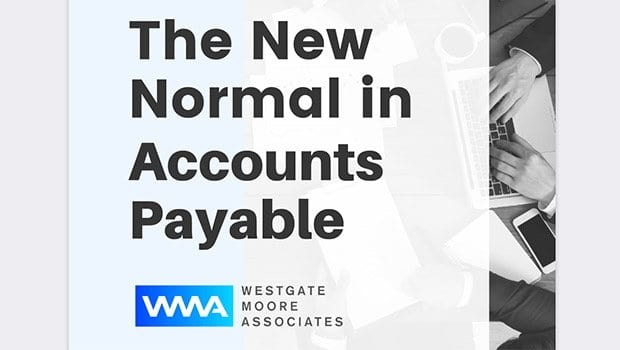
Oct
The New Normal in Accounts Payable
Accounts payable (AP) functions are some of the most transactionintensive environments within a medium to large scale business. Endlessemails, faxes, and piles of post, come into the AP function on a dailybasis. The amount of incoming paper is thankfully starting to decrease;however many AP teams will receive invoices via email or an EDI, andthen print them off!
Historically, and even for some AP functions currently, the accountspayable process has been, and still is, a manual one. The process is in 5stages:
- Receive invoices from suppliers – by email, fax orpost – postal invoices are date stamped.
- Invoices are assigned to clerks for entering into ERP
- The invoices are entered by clerks
- Invoices are then approved for payment
- A payment run is conducted and remittances sent
AP teams has never been a remote function; with paper based systemsrequiring AP clerks being ‘chained’ to their desks entering invoices forpayment.March 2020 – the whole of England is forced into lockdown, with officebased work only allowed for essential and key workers.
The hurdles and obstacles needed to be overcome to enable many APfunctions to pivot and transform to a remote function are mindboggling. There are some horror stories; you hear of AP functions wholost the majority of their team due to employees being placed onfurlough and a number of employees having to self-isolate or in factshielding due to their age. AP functions then had to operate on skeletonstaff, but still being required to pay the bills and carry a similar level ofworkload for a full team.
We recently spoke with Rachael Long, Group Accounts Payable Managerfor The Breedon Group and asked her how her team have succumbedor embraced the changes to accounts payable working practices in 2020.

How did you manage the lines of communication with yoursuppliers?
How did you manage the lines of communication with your suppliers – no change to supplier communication, as we used Jabra which was re-directed from our internal phone system through our laptops and we used head sets.
What are the major differences in how you operate today, as an AP function, compared to 12 months ago?
We had to change the way we worked as we were very paper based and clunky, we become more efficient very quickly. We now have a rota system within the home/office now, Perspex screens in between desks and what seems like very empty offices.
What have been the major challenges, and how have you overcome these?
Managing team members exceptions, ensuring they felt safe and supported in coming back to work and back to the office, myself and other managers worked hard to ensure the team members were supported from a mental health perspective. Health and wellbeing, flexible working is something we wanted to ensure was being promoted and supported We put up signage, provide individual hand sanitisers for each desk, anti-bacterial wipes are placed in numerous areas around the office. Social distancing is always adhered to within the office and the seating has been changed to ensure team member feel comfortable.
My team are used to being out and about within the business so this has been a different experience, training via teams rather than travelling to sites, more phone and video calls, with team members pets and family (always encouraged)The ways in which Accounts Payable functions operate has drastically changed. The front line of all medium and large sized businesses have had to adapt pretty quickly. We are now seeing a new normal; a balance of office and remote work – something which 6 months ago would have been unprecedented for many AP teams.We have also spoke with Stewart Griffiths, the Payments Manager at Bio Products Laboratory; he mentions similar responses to Rachael at the Breedon Group in terms of communication with his team. Laptops were also given to the AP clerks in readiness to work from home. The team were given mobile phones also, with the office number diverted to mobile phone numbers to ensure inbound calls could still be answered.
When asked about the differences in how his team looks today, compared with 12 months ago, the response was “technology” – and how they are embracing tech to enable continued communication with their team. Stewart comments,
“The world of AP is changing fast, more and more business leaders are starting to realise the importance of their AP function and how it can add value to their process improvement and implementation of the right technologies in order to deliver efficiencies and cost savings. Increased collaboration with procurement teams in order to deliver a world class P2P process, by educating colleagues in P2P best practices and again looking at technology to further enhance processes in the procurement function. Finally businesses analytics and the insights it brings in order for a business to make quick and well informed decisions will become more of a necessity as business information is important in all departments, not only Accounts Payable. Accounts Payable is about continuous improvement in its processes, its people and the technologies it uses”

